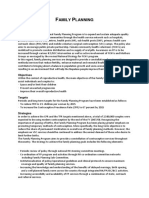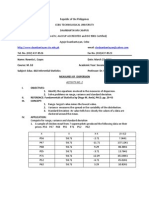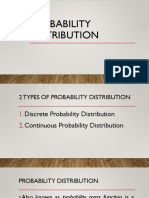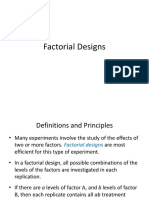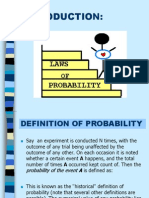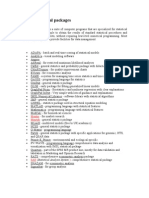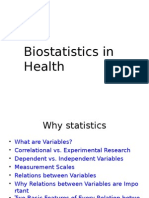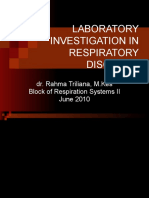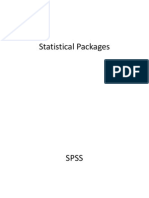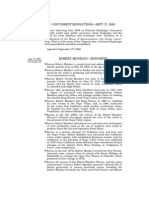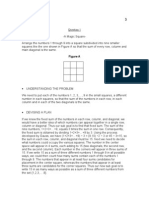Chi Square (KI Square) Test
Chi Square (KI Square) Test
Uploaded by
nyiisonlineCopyright:
Available Formats
Chi Square (KI Square) Test
Chi Square (KI Square) Test
Uploaded by
nyiisonlineOriginal Description:
Original Title
Copyright
Available Formats
Share this document
Did you find this document useful?
Is this content inappropriate?
Copyright:
Available Formats
Chi Square (KI Square) Test
Chi Square (KI Square) Test
Uploaded by
nyiisonlineCopyright:
Available Formats
Chi Square (KI Square) Test
test
2
_
Chi square test
A chi square test is an inferential statistic
Analyzes proportions/frequency data
Uses proportions/distributions from a sample to
test hypotheses about proportions/ distributions
in the population
3
1. Determine Appropriate Test
Chi Square is used when both variables are
measured on a nominal scale.
It can be applied to interval or ratio data that have
been categorized into a small number of groups.
It assumes that the observations are randomly
sampled from the population.
All observations are independent (an individual
can appear only once in a table and there are no
overlapping categories).
It does not make any assumptions about the
shape of the distribution nor about the
homogeneity of variances.
_
2
test
For testing significance of patterns in
qualitative data
Test statistic is based on counts that
represent the number of items that fall in
each category
Test statistics measures the agreement
between actual counts and expected counts
assuming the null hypothesis
Chi-squared Tests
_
2
Distribution
The chi-square distribution can be used to
see whether or not an observed counts
agree with an expected counts. Let
O = observed count and
E = Expected count
Chi-squared Distribution
=
E
E O
2
) (
2
_
The chi square test can only be used on data that
has the following characteristics:
The data must be in the form
of frequencies
The frequency data must have a
precise numerical value and must be
organised into categories or groups.
The total number of observations must be
greater than 20 to obtain the precise
result of chi square test.
The expected frequency in any one cell
of the table must be greater than 5.
Total number of frequency must be
large that is N greater than 50
Chi square test has several applications .
Some important applications of this test are
as follows
Test of goodness of fit
Test of independence of attributes
Two chi square tests
Goodness of fit
One variable
Determines how well the sample proportions
match a pre-specified distribution
Independence
Two variables
Determines whether there is a relationship
between two variables
Steps in hypothesis testing
1. State the hypotheses
null
alternative
2. Select an alpha level and determine the critical value
3. Compute the test statistic
4. Make a decision
Test for goodness of fit
Forms of the null hypothesis
1. No preference
There is no difference in proportions among the categories
Participants do not prefer one category over another
Example: Pepsi: 50%, Coke 50%
2. No difference from a comparison population
There is no difference between the sample distribution and a
known (population) distribution
Calculating the test statistic
Observed frequencies
the number of individuals from the sample who
are classified in a particular category
O
Expected frequencies
the number of individuals from the sample who
are expected to be classified in a particular
category
E
Calculating the test statistic
Heads Tails
Percentages 50%
50%
Proportions .5 .5
Consider an example of Coin flip
Null hypothesis H
o
: coin is unbiased
Alternative hypothesis H
1
: coin is biased
Calculating the test statistic
Expected Heads Tails
Proportions .5 .5
Frequencies 25 25
Expected frequency = O
N= 50 (sample size)
Under H
0
: coin unbiased
E = .5 x 50 = 25
Calculating the test statistic
N= 50
Following are the number of head and tail
observed in tossing a coin 50 times.
Heads Tails
Observed 35 15
Calculating the test statistic
Heads Tails
Observed 35 15
Expected 25 25
Steps
1. find the difference between O and E for
each category
2. square the difference
3. divide the squared difference by O
4. sum the values from all categories
| |
( )
=
2
2
E
E O
_
= 4 + 4 = 8
Heads Tails
Observed (O) 35 15
Expected (E) 25 25
O - E
10 -10
(O - E)
2
100 100
(O - E)
2/
E 4 4
( )
=
2
2
E
E O
_
Test for goodness of fit
The greater the number of categories, the
greater the likelihood of a large observed chi
square value
Degrees of freedom (df)
The number of values that are free to vary
df = C 1
C = the number of categories
Chi square distribution
Critical values for chi square distribution
Chi square distribution
x
2
0 3.84
5%
Critical value (df = 1, o = .05) = 3.84
Goodness of fit
Make a decision
Critical value = 3.84 with df = 1 and o = .05.
Observed chi square = 8.0
8.0 > 3.84
Observed chi square is greater than critical value
We reject the null hypothesis
Conclude that category frequencies are different
People were more likely to predict heads than tails
2 x 2 contingency tables
Var A
Var B
a1
a2
b1 b2
total
total
Ho : The two variable are independent
Ha : The two variables are associated
Chi-squared test for independence of Attributes
Operator
Result
A
B
def
Not def.
total
total
100 900 1000
60 440 500
160 1340 1500
_
2
test
_
2
test
Operator
Result
A
B
def
not
def.
total
total
100 900 1000
60 440 500
160 1340 1500
Total number of items=1500
Total number of defective items=160
Overall defective rate =160/1500=0.1067
Now, apply this rate to the number of items
produced by each operator.
_
2
test
Operator
Result
A
B
def Not def.
total
total
100 900 1000
60 440 500
160 1340 1500
Expected defective from Operator A
= 1000 * 0.1067 = 106.7
(expected not defective=1000-106.7=893.3)
Expected defective from Operator B
= 500 * 0.1067 = 53.3
(expected not defective=500-53.3=446.7)
Expected frequency = row total x column total
Grand total
Alternatively in case of contingency table
expected frequency can calculate as follow
_
2
test
Operator
Expected
A
B
def
Not def.
total
total
106.7 893.3
53.3 446.7
Result
Operator
A
B
def Not def.
total
total
100 900
1000
60 440 500
160 1340 1500
Observed Expected
100 106.7
60 53.3
900 893.3
440 446.7
( )
=
2
2
E
E O
_
_
2
test
r x c contingency tables
SA A NO D SD
Gr 1 12 18 4 8 12
Gr2 48 22 10 8 10
Gr3 10 4 12 10 12
_
2
test
use when you have categorical data
measure the difference between actual counts
and expected counts
test the independence of two variables
Assumptions:
data set is a random sample
you have at least 5 counts in each category
degrees of freedom =
(categories var1 -1)(categories var2 -1)
You might also like
- 7 Habits of Effective PeopleDocument4 pages7 Habits of Effective PeopleNor-rahma RegaroNo ratings yet
- The Effects of Social Media On Mental HealthDocument2 pagesThe Effects of Social Media On Mental Healthfatin100% (2)
- A Critique On Philippine Bureaucratic BehaviorDocument2 pagesA Critique On Philippine Bureaucratic BehaviorJohn Lester Tan83% (6)
- Hydrocephalus IDocument52 pagesHydrocephalus IVlad Alexandra50% (2)
- DELEGATIONDocument9 pagesDELEGATIONMHIEMHOINo ratings yet
- Statistics in Research 3Document22 pagesStatistics in Research 3Khrysthine Laurhen BechaydaNo ratings yet
- Common Types of VariablesDocument5 pagesCommon Types of VariablesTd Devi AmmacayangNo ratings yet
- 4 Year B.P.T. Subject: Physiotherapy in OrthopaedicsDocument36 pages4 Year B.P.T. Subject: Physiotherapy in OrthopaedicsNageswaraRoyal GovindugariNo ratings yet
- Quartiles, Deciles, PercentilesDocument5 pagesQuartiles, Deciles, PercentilesRomeo Jr Pacheco Opena100% (1)
- Need For Research DesignDocument12 pagesNeed For Research DesignPramod KumarNo ratings yet
- Sample Size Determination ExercisesDocument2 pagesSample Size Determination ExercisesMINANI TheobaldNo ratings yet
- Test Statistics Formulas For Probabiltity and StatisticsDocument6 pagesTest Statistics Formulas For Probabiltity and StatisticsJet Niko BrizuelaNo ratings yet
- Module 1 - NeuropsychologyDocument4 pagesModule 1 - Neuropsychologyaysha farihaNo ratings yet
- Unit4 Fundamental Stat Maths2 (D)Document28 pagesUnit4 Fundamental Stat Maths2 (D)Azizul AnwarNo ratings yet
- Ch. 7 - Sampling and Infrential StatisticsDocument27 pagesCh. 7 - Sampling and Infrential StatisticsNour MohamedNo ratings yet
- Approach To AtaxiaDocument6 pagesApproach To AtaxiaVivek KumarNo ratings yet
- DILSHAD - Study DesignsDocument48 pagesDILSHAD - Study DesignsAamir IjazNo ratings yet
- Chi SquaredDocument15 pagesChi SquaredArlenie Manog MadeloNo ratings yet
- Sign TestDocument8 pagesSign TestRams KbNo ratings yet
- National Health ProgramsDocument19 pagesNational Health ProgramsSANANo ratings yet
- Activity No. 2Document12 pagesActivity No. 2Keennan L. CuyosNo ratings yet
- Chi Square Test: Dr. Krishan K. PandeyDocument7 pagesChi Square Test: Dr. Krishan K. PandeyOm PrakashNo ratings yet
- L3 Dynamics of Disease TransmissionDocument32 pagesL3 Dynamics of Disease TransmissionTheBoss 20No ratings yet
- Chapter 1. BiostatisticsDocument34 pagesChapter 1. BiostatisticsHend maarofNo ratings yet
- Chi Square TestDocument5 pagesChi Square TestToman Chi To LamNo ratings yet
- Statistics: Shaheena BashirDocument37 pagesStatistics: Shaheena BashirQasim RafiNo ratings yet
- Poisson Regression and Negative Binomial RegressionDocument34 pagesPoisson Regression and Negative Binomial Regressiondanna ibanez100% (1)
- Chi Square StatisticsDocument7 pagesChi Square StatisticsNoviana Dian UtamiNo ratings yet
- Paired Sample T-TestDocument6 pagesPaired Sample T-TestAiswarya Rokkam KoppuNo ratings yet
- Z Test T Test For StudentsDocument6 pagesZ Test T Test For StudentsTeamon MallariNo ratings yet
- Continuous Probability Distribution PDFDocument47 pagesContinuous Probability Distribution PDFDipika PandaNo ratings yet
- Probability DistributionDocument10 pagesProbability DistributionLëryNo ratings yet
- Biostatistics Lecture - 1 - IntroductionDocument36 pagesBiostatistics Lecture - 1 - IntroductionDr. Mahmoud Abbas Mahmoud Al-Naimi50% (4)
- Reliability and Validity of ScaleDocument11 pagesReliability and Validity of ScaleVIKAS DOGRA100% (1)
- ANOVA and RegressionDocument1 pageANOVA and Regressiontkhattab999No ratings yet
- I P S F E Sampling Distributions: Ntroduction To Robability AND Tatistics Ourteenth DitionDocument37 pagesI P S F E Sampling Distributions: Ntroduction To Robability AND Tatistics Ourteenth DitionRicky Justin NgoNo ratings yet
- Paired T TestDocument24 pagesPaired T TestpriyankaswaminathanNo ratings yet
- 03 Cardiopulmonary PhysiologyDocument17 pages03 Cardiopulmonary Physiologyice cream1000791100% (1)
- BiomechanicsDocument52 pagesBiomechanicsLukman HakimNo ratings yet
- Pancreas: Functions and Possible Problems: FeaturesDocument8 pagesPancreas: Functions and Possible Problems: FeaturesthenameisvijayNo ratings yet
- Factorial Designs PDFDocument25 pagesFactorial Designs PDFJean Jacques Monga KabokoNo ratings yet
- Correlation and RegressionDocument24 pagesCorrelation and Regressionkaushalsingh2080% (5)
- Laws of ProbabilityDocument5 pagesLaws of ProbabilityRizziel NemesNo ratings yet
- List of Statistical PackagesDocument2 pagesList of Statistical Packagestavishi dhawanNo ratings yet
- Statistics IntroductionDocument55 pagesStatistics IntroductionRahul DhakerNo ratings yet
- Laboratory Investigation in Respiratory DiseasesDocument46 pagesLaboratory Investigation in Respiratory DiseasesWin Indra Wicaksono100% (2)
- Introduction To Biostatistics1Document23 pagesIntroduction To Biostatistics1Noha SalehNo ratings yet
- Friday May 30Document24 pagesFriday May 30api-249610248No ratings yet
- Statistical PackagesDocument32 pagesStatistical PackagesPalaniappan SellappanNo ratings yet
- Class 1 - BinomialDocument25 pagesClass 1 - Binomialkabbilaash kumarNo ratings yet
- A5 - One-Way ANOVADocument32 pagesA5 - One-Way ANOVAChristian Daniel100% (1)
- L 7estimating RiskDocument63 pagesL 7estimating RiskRizwan ShameemNo ratings yet
- Chi Squared TestDocument17 pagesChi Squared TestsanthiNo ratings yet
- Student's T TestDocument56 pagesStudent's T TestmelprvnNo ratings yet
- Survival AnalysisDocument30 pagesSurvival AnalysisAniruddh SarkarNo ratings yet
- Tetanic Contraction - WikipediaDocument9 pagesTetanic Contraction - WikipediaSIBANI CHAUDHURYNo ratings yet
- Measures of LocationDocument33 pagesMeasures of LocationMahmud HasanNo ratings yet
- Different Types of Sampling DesignsDocument12 pagesDifferent Types of Sampling Designsshincepeterms100% (5)
- Tests of HypothesisDocument23 pagesTests of HypothesisHazel PapagayoNo ratings yet
- Operational ResearchDocument19 pagesOperational ResearchKamal MishraNo ratings yet
- 1-Introduction To EpidemiologyDocument22 pages1-Introduction To EpidemiologyANTHONY KHAOYANo ratings yet
- Repeated Measures Design PDFDocument44 pagesRepeated Measures Design PDFwahida_halimNo ratings yet
- Unit 3 - ChisquareDocument65 pagesUnit 3 - Chisquareesasc.swayamNo ratings yet
- Chapter 3 - 2 Chi Square Test Other TestsDocument27 pagesChapter 3 - 2 Chi Square Test Other TestsandrinaNo ratings yet
- 122 STAT. 5204 Concurrent Resolutions-Sept. 27, 2008: Robert Mondavi-HonoringDocument2 pages122 STAT. 5204 Concurrent Resolutions-Sept. 27, 2008: Robert Mondavi-HonoringnyiisonlineNo ratings yet
- Linear Programming: The Simplex MethodDocument134 pagesLinear Programming: The Simplex MethodnyiisonlineNo ratings yet
- Personality: Presented By: Bal Ram Chapagain, M. PhilDocument23 pagesPersonality: Presented By: Bal Ram Chapagain, M. PhilnyiisonlineNo ratings yet
- Statistics and MBADocument27 pagesStatistics and MBAnyiisonlineNo ratings yet
- 3rd COT DLLDocument2 pages3rd COT DLLConnie Reyes San Gabriel83% (6)
- Terri Mauro: Panic AttacksDocument7 pagesTerri Mauro: Panic AttacksFudgeKeykNo ratings yet
- Paraphrase Practice 3Document4 pagesParaphrase Practice 3hohoanghanNo ratings yet
- Alchemy of Quantum Tantra EbookDocument44 pagesAlchemy of Quantum Tantra EbookBlane100% (4)
- Test 16 (G12)Document4 pagesTest 16 (G12)quan Nguyen minhNo ratings yet
- Crafts SyllabusDocument3 pagesCrafts Syllabusapi-279660401No ratings yet
- VP Operations Performance Management in Tampa ST Petersburg FL Resume George HoskinsonDocument2 pagesVP Operations Performance Management in Tampa ST Petersburg FL Resume George HoskinsonGeorgeHoskinsonNo ratings yet
- MBG4234234 PDFDocument531 pagesMBG4234234 PDFVishwamedhi Kadavilla100% (1)
- Equality and Diversity in SocietyDocument2 pagesEquality and Diversity in Societyredpete1No ratings yet
- GCC TBC 40 170615Document17 pagesGCC TBC 40 170615Sampada lolageNo ratings yet
- Impulsive BuyingDocument23 pagesImpulsive Buyingshawinder_sainiNo ratings yet
- Power of ReadingDocument1 pagePower of ReadingJocelyn Nicole Muñoz MoragaNo ratings yet
- Barrier To CommunicationDocument20 pagesBarrier To Communicationyounas khanNo ratings yet
- The Maxims of Good WritingDocument4 pagesThe Maxims of Good WritingJudithMartínRodríguez0% (1)
- Episodes in The Life of Francesca WilsonDocument369 pagesEpisodes in The Life of Francesca WilsonArsa Arrikitaun100% (1)
- Creativity: Theories, Prediction, and EtiologyDocument111 pagesCreativity: Theories, Prediction, and EtiologyRelaxing music, Meditation & Sleep - Moon ChildNo ratings yet
- Matroiannipangori - Apples Culture Final PaperDocument19 pagesMatroiannipangori - Apples Culture Final Paperapi-301897682No ratings yet
- College of Teacher EducationDocument3 pagesCollege of Teacher EducationYuri PamaranNo ratings yet
- Tantrums Upset Crying BIPDocument3 pagesTantrums Upset Crying BIPNataliaNo ratings yet
- A Magic SquareDocument10 pagesA Magic Squarecikgu ikwanNo ratings yet
- Syllabus: MODULE 1: The Motor Cortex and Corticospinal TractDocument6 pagesSyllabus: MODULE 1: The Motor Cortex and Corticospinal TractvirtuahNo ratings yet
- The Musical NeuronsDocument169 pagesThe Musical NeuronsChloe Bujuoir100% (1)
- Jitf Mikes Bikes Business CourseDocument5 pagesJitf Mikes Bikes Business CourseDevikaNo ratings yet
- Group 4 PPDocument14 pagesGroup 4 PPMika ValenzuelaNo ratings yet
- LET (Prof 1) Child and Adolescent DevelopmentDocument3 pagesLET (Prof 1) Child and Adolescent DevelopmentShaineMaiko Marigocio100% (1)
- The Female EunuchDocument4 pagesThe Female EunuchShachi Sood0% (3)



















